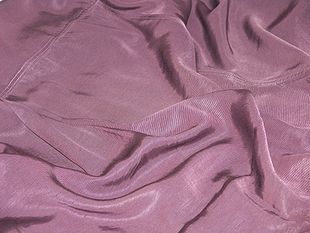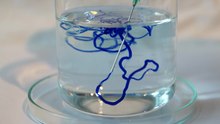Cupro
Cupro (short CUP ), also copper silk or copper fiber , is a textile fiber made from regenerated cellulose . The properties of cupro are comparable to viscose . Cupro fibers are mainly processed into lining materials because they are breathable , hygroscopic and do not become statically charged . In addition, the fabrics have a silky soft feel and are smooth and shiny. Cupro can be washed and ironed, but it is not iron-free.
Historical and usage
As early as 1857, the Zurich chemistry professor Matthias Eduard Schweizer (1818–1860) discovered that cellulose can be dissolved in a solution of copper (II) hydroxide in ammonia water ( Schweizer's reagent ). The French patent no. 203 741 from 1890 by Louis-Henri Despaissis can be regarded as the beginning of the technical use of this observation . Because of the early death of the inventor, there was no commercial exploitation of the invention. In 1897, the chemist Max Fremery and the engineer Johann Urban applied for a patent for their process of making threads from liquefied cellulose. However, Fremery and Urban initially only used these copper rayon filaments as filaments in their incandescent lamp factory in Oberbruch near Aachen (city of Heinsberg ), which they opened in 1892 . After further improvements, in 1899 they were finally able to use their process to produce usable copper rayon threads for the textile industry, and so the United Glanzstoff-Fabriken AG was founded on September 19, 1899 in Elberfeld (a district of Wuppertal since 1929 ) , whose main plant was still located in Oberbruch. The most important purchaser of the copper artificial silk was the Bergische trimming industry .
In parallel, began in 1900 in Wuppertal Oberbarmen the development work on the copper rayon production of J. P. Bemberg AG, as its raw material from 1908 Linter said non-spinnable short seed hairs of cotton seed served. A new draw spinning process developed by Edmund Thiele in 1901 at J. P. Bemberg made it possible to produce a yarn from this raw material, which - known as Bemberg silk - corresponded in its fineness to natural silk and also had greater strength than viscose rayon owned.
In 1902, Fremery and Urban closed their light bulb factory in order to dedicate themselves to the production of artificial silk from then on. The two quickly recognized the future potential of artificial silk , and so in 1910/1911 they first acquired the “Fürst Guido Donnersmarckschen artificial silk and acetate works” in Sydowsaue near Stettin (today Szczecin-Żydowce, Poland) and then their viscose patents in order to improve them further .
Cupro was very popular for a long time as a lining material, for the manufacture of outerwear and for accessories. For reasons of cost and environmental protection, however, it is no longer manufactured in Germany and is replaced by viscose or other fibers. Cupro can still be found in imported fabrics.
Until the 1980s, cuprophane was the most frequently used material, which was used as a membrane material in dialyzers for extracorporeal dialysis . Today mainly synthetic materials with better biocompatibility such. B. polysulfone is used.
Manufacturing
Cupro is produced using the copper oxide-ammonia process (Cuoxam process). In this process, chemical pulp is dissolved in an ammoniacal solution of tetraammine copper (II) hydroxide . The result is a viscous solution that contains 4% copper , 29% ammonia and 10% cellulose . If this liquid is pressed through spinnerets into warm water that flows quickly , the cellulose precipitates as a very fine thread (draw-spinning process). The copper ions are removed via ion exchangers and the fibers are washed out with dilute sulfuric acid .
literature
- Detailed information about Bemberg from the manufacturer Asahi Kasei .
- Article Cupro and copper fiber In: Brockhaus Enzyklopädie . online, Bibliographisches Institut & FA Brockhaus AG, 2005–2009.
- GB Kauffmann: A brief History of Cuprammonium Rayon in Seymour. In: RB u. RS Porter: Manmade Fibers: Their Origin and Development. Elsevier, London / New York 1993, ISBN 978-1-85166-888-5 .
- H. Jentgen: The development of the process for the production of copper artificial silk . In: Chemiker-Zeitung , 66, 1942, pp. 502-503, 523-525.
Individual evidence
- ↑ Kunstseide ( Memento of the original from August 29, 2010 in the Internet Archive ) Info: The archive link has been inserted automatically and has not yet been checked. Please check the original and archive link according to the instructions and then remove this notice. at the stocking museum.
- ↑ Coated and baked . In: Die Zeit , No. 22/1995. “Copper, more precisely copper oxide-ammonia, is used as a solvent in the manufacture of copper silk. Copper ions end up in the wastewater and disturb the ecological balance, because copper is a strong poison for all lower plants such as algae and small mushrooms. This metal cannot be filtered out of the wastewater. 'There is no adequate wastewater treatment for substances containing copper'. "

